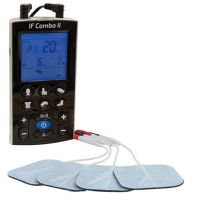 Written by Dr. Eric Wood, ND, MA
Written by Dr. Eric Wood, ND, MA
Pain and the loss of mobility can both negatively impact our quality of life. While most diseases and injuries can cause pain along with impaired joint mobility, chronic pain that frequently limits our life or work activities remains one of the most common reasons adults seek medical care. In addition, work-related musculoskeletal disorders and injuries that limit the range of motion and make it impossible to move around easily are the leading cause of temporary and permanent disability for people during their working years. Even the disability caused by a stroke is thought to take second place to both arthritis and back pain as far as the overall impact on functional limitations.
Thankfully, advancements in pain and motion technology have brought us healthier and more effective options than addictive medications like opioids and invasive procedures like surgery in order to relieve pain, manage contractures, and optimize the range of movement. Therapeutic ultrasound and TENS (Transcutaneous Electrical Nerve Stimulation) therapy are often used in physical therapy practices and recommended by healthcare professionals for their patients to use at home. While both are efficacious therapy modalities, we invite you to read more about ultrasound therapy and TENS therapy so you can determine the best approach for your unique requirements.
 | InTENSity Portable Muscle Stimulator Therapy Devices - 2 Styles View Product |
| Sonicator 740 Therapeutic Ultrasound Unit View Product |
Frequently utilized to treat similar conditions, ultrasound therapy and TENS therapy can both help to alleviate pain and relax the contractures that limit our range of movement (ROM). Non-invasive and drug-free, both of these therapies are relatively inexpensive as well. Ideal for people who do not want to take drugs, along with those who have found medications, surgery, and other approaches to be ineffective, TENS and therapeutic ultrasound offer a viable alternative to more traditional medical protocols. They can also help to optimize treatment as an adjunct with other therapy modalities. However, there are some key differences which we discuss below.
Recommended: InTENSity Portable Muscle Stimulator Therapy Devices - 2 Styles
Recommended: Sonicator 740 Therapeutic Ultrasound Unit
TENS therapy uses electrical currents in adjustable levels of frequency intensity, targeting specific areas of the body to mitigate pain, relax muscles, decrease atrophy, reduce swelling/edema, and improve range of motion. Although its exact mechanism of healing is still unknown, the most popular theory of how TENS works is that its electrical stimulation keeps the nerves so busy, they are not able to process pain signals. This electrical stimulation may also encourage the brain to switch the balance of its chemical production to more natural pain relievers, such as endorphins.
Ultrasound therapy uses varying levels of sound wave frequencies that are transmitted to affected areas of the body, creating a mechanical vibration of the connective tissues. Adjustable in frequency to change depth and temperature, the heat created by the sound waves increases blood flow, delivering crucial nutrients to the cells and removing waste from the tissues. Passing through the skin, ultrasound therapy expands and contracts into the affected tissue to reduce pain, decrease inflammation, enhance soft tissue mobility, and promote healing.
Generally the size of a small cell phone, a TENS unit powers adhesive electrodes that are attached to the skin near the targeted area. Depending on the model, these electrodes may be connected to the TENS unit with lead wires, or activated remotely through wireless connectivity. The intensity of the electrical current delivered can be adjusted with controls on the TENS unit and treatment times can be as long as needed to achieve the pain relief desired.
An ultrasound therapy machine for home use is typically smaller and less involved than those used clinically by healthcare professionals like physical therapists. The sound waves and therapeutic thermal heat it creates are transmitted via a handheld soundhead constantly moving over the body areas requiring treatment. A gel is used to couple the soundhead to the patient, protecting the skin from the heat that therapeutic ultrasound generates.
Treatment times vary for both TENS therapy and ultrasound therapy depending on the unique needs of the individual. On average, most people get the results they need with a 30-minute TENS therapy session, while ultrasound therapy sessions usually only take about 5 to 15 minutes to achieve relief.
One of the most popular aspects of TENS therapy is how convenient it is to use. While ultrasound therapy requires the user or someone else to continuously hold onto the soundhead during the entire course of treatment, you can actually access TENS therapy on the go. Battery-operated TENS units are exceptionally small and portable, enabling them to fit in a pocket or clip to a belt. Once the electrodes are in place, you can enjoy this therapy while you’re working, exercising, shopping, or essentially doing anything else. Ultrasound therapy devices designed for home use are usually lightweight and portable so you can take them along wherever you roam, but access to the actual therapy requires staying in one place for the length of the session.
Another point in TENS’ favor is its immediacy - traveling along the nerve fibers, the electrical impulses from TENS therapy create a tingly sensation, relieving pain immediately once the unit is powered on. This stimulation of the nerves closes a gate mechanism that relates to the sensation of pain, blocking the pain signals from reaching the brain. While the duration of pain relief can vary, research suggests that repeated TENS treatments increase how long a user will feel this relief between sessions. With ultrasound therapy, it can take a few sessions to achieve the level of pain relief users are seeking. Depending on the pathology to be treated, the user’s general state of health, and the selected intensity, some users may notice positive results after the very first ultrasound therapy session, while others may require several treatments before they attain significant relief.
For people with more involved medical conditions who require pain relief along with deeper healing, ultrasound therapy is usually going to be the better option over TENS therapy. Healing the body at the cellular level, therapeutic ultrasound is often used as an effective treatment for a wide variety of conditions that cause pain, inflammation, and contractures that limit the range of motion. TENS therapy essentially blocks the perception of pain, but it doesn’t directly heal the body like ultrasound therapy. The capability of ultrasound to heal the body from within makes it the optimal choice for some users living with conditions like arthritis, ganglion, and tendonitis, while others can find the simple pain relief they seek with TENS.
One of the reasons TENS therapy is so widely used is that it’s so affordable - you can generally find quality TENS units ranging anywhere from just $30 to $200. You can also find many good ultrasound therapy devices for home use that land within that range as well, but more involved models designed for clinical use can cost several thousand dollars. Whatever you choose, it’s important to ensure the device comes with the features you want for the amount you’re paying.
TENS therapy is convenient and works fast, there’s no doubt about it. If you’re looking to treat pain as a symptom and don’t have many other health issues, it’s a great option. However, if you live with a long-term or more involved medical condition that requires a more holistic approach, ultrasound therapy might be a better choice. Like TENS, therapeutic ultrasound helps to manage pain in the short term, but it also helps to heal the body in the long term.
Yes, you can use both TENS therapy and ultrasound therapy together, and they actually synergize quite well, creating stronger and more effective healing and pain relief. While the thermal effects from ultrasound boost circulation to optimize healing mechanisms within the body, the electrical stimulation from TENS completes a nerve block, helping to retrain the pain receptors. In most treatment plans, physical therapists and other medical professionals use combined modalities to maximize results. Some devices will conveniently combine both therapies for treatment versatility, like the UltraTENS II Ultrasound and TENS unit - an exceptional, highly affordable device that’s also easy to operate.
Frequently used for pain management along with increasing the range of motion, ultrasound therapy and TENS therapy are important, powerful tools that help people of all ages to improve functionality and reduce disability. Often utilized by physical therapists in their clinical practice, non-invasive and drug-free TENS units and ultrasound machines are also recommended for patients to use at home to keep the therapy going in a positive direction.
Although TENS therapy is optimal for quick pain relief and therapeutic ultrasound is more suitable for deep healing, combining both modalities maximizes efficacy, healing, and relief. Thanks for taking the time to learn more about these popular healing therapies, and we invite you to read about many more helpful tools for the job of living at our Caregiver University blog.

Dr. Wood is a licensed naturopathic doctor in Washington D.C. and founder of Visionary Health. A graduate of the Canadian College of Naturopathic Medicine, Dr. Wood is a professor at John Patrick University in the Integrative and Functional Medicine Department as well as an adjunct professor at the American College of Healthcare Sciences in Holistic Nutrition. He began his career as a specialty physician for two leading supplement US companies, Neuroscience Inc. and Life Extension. Over his fifteen-year career in integrative and holistic medicine, he has worked in diverse capacities including as an educator; writer; medical advisor, consultant and formulator for supplement companies and treatment centers in the US and the EU; public speaker; and clinician. He has long been a practicing advocate of lifestyle medicine, fitness and mind body medicine approaches initially spurred by aging family members not getting help from traditional medicine and is passionate about innovating and bringing natural and integrative medicine to the masses!